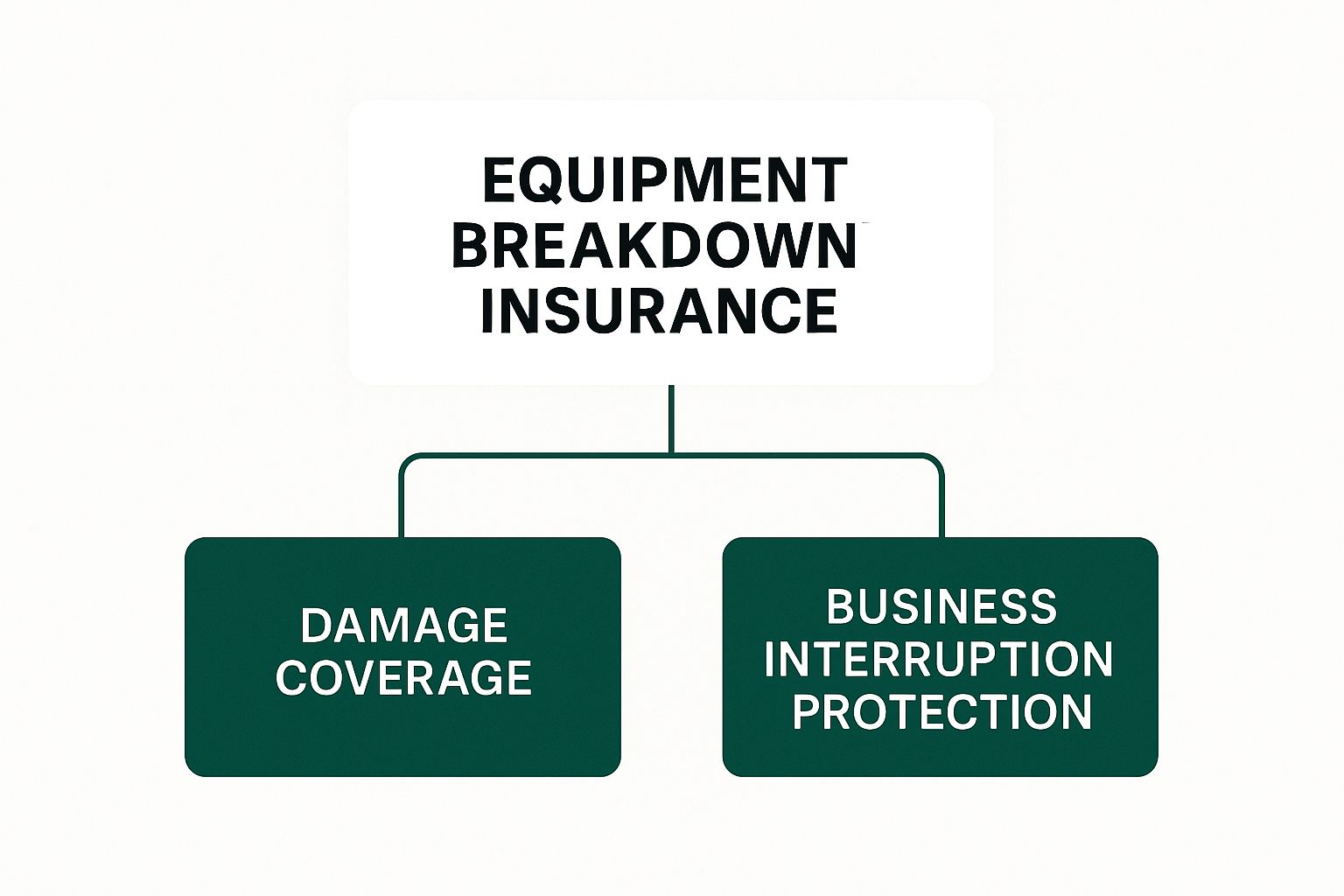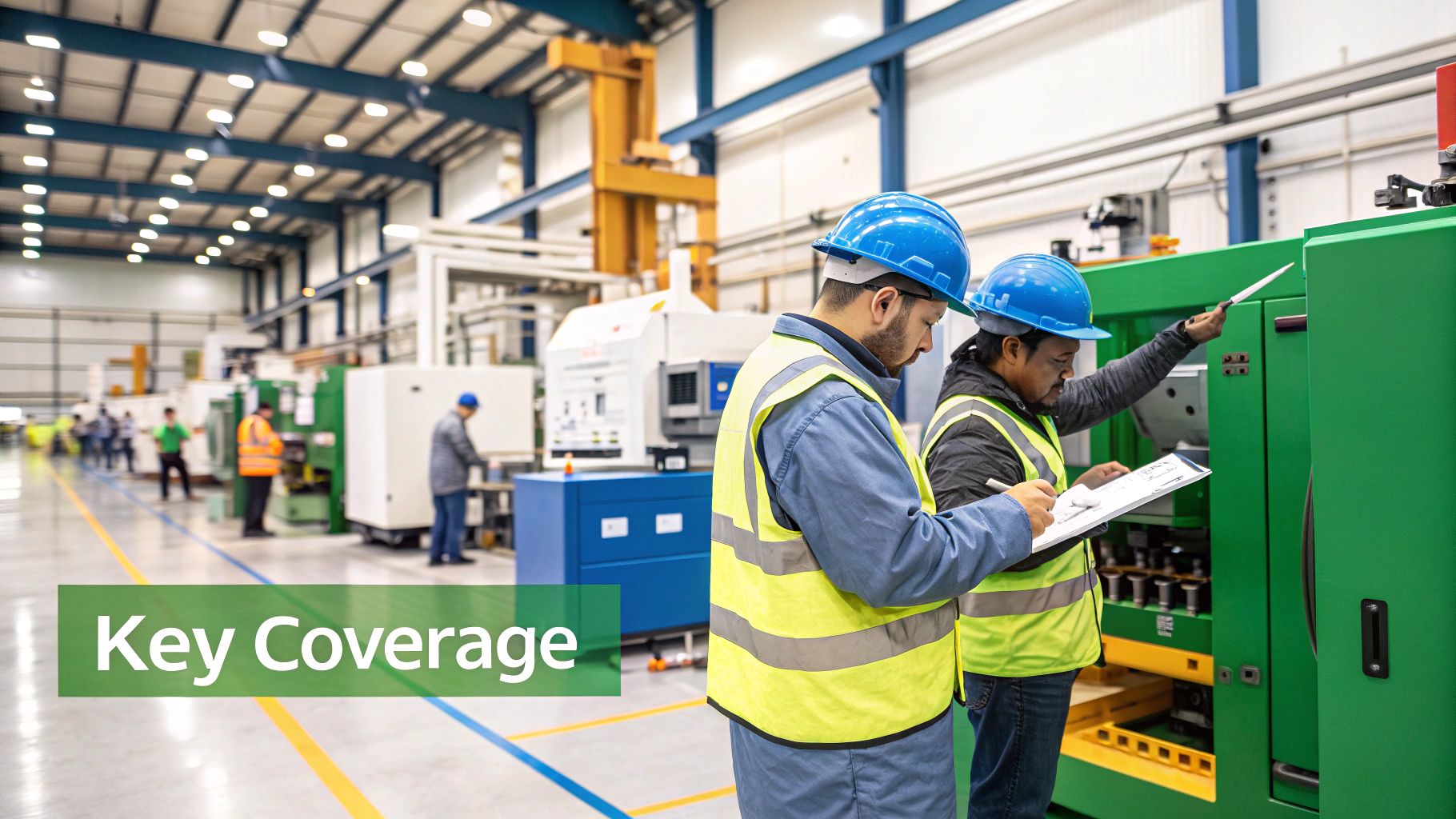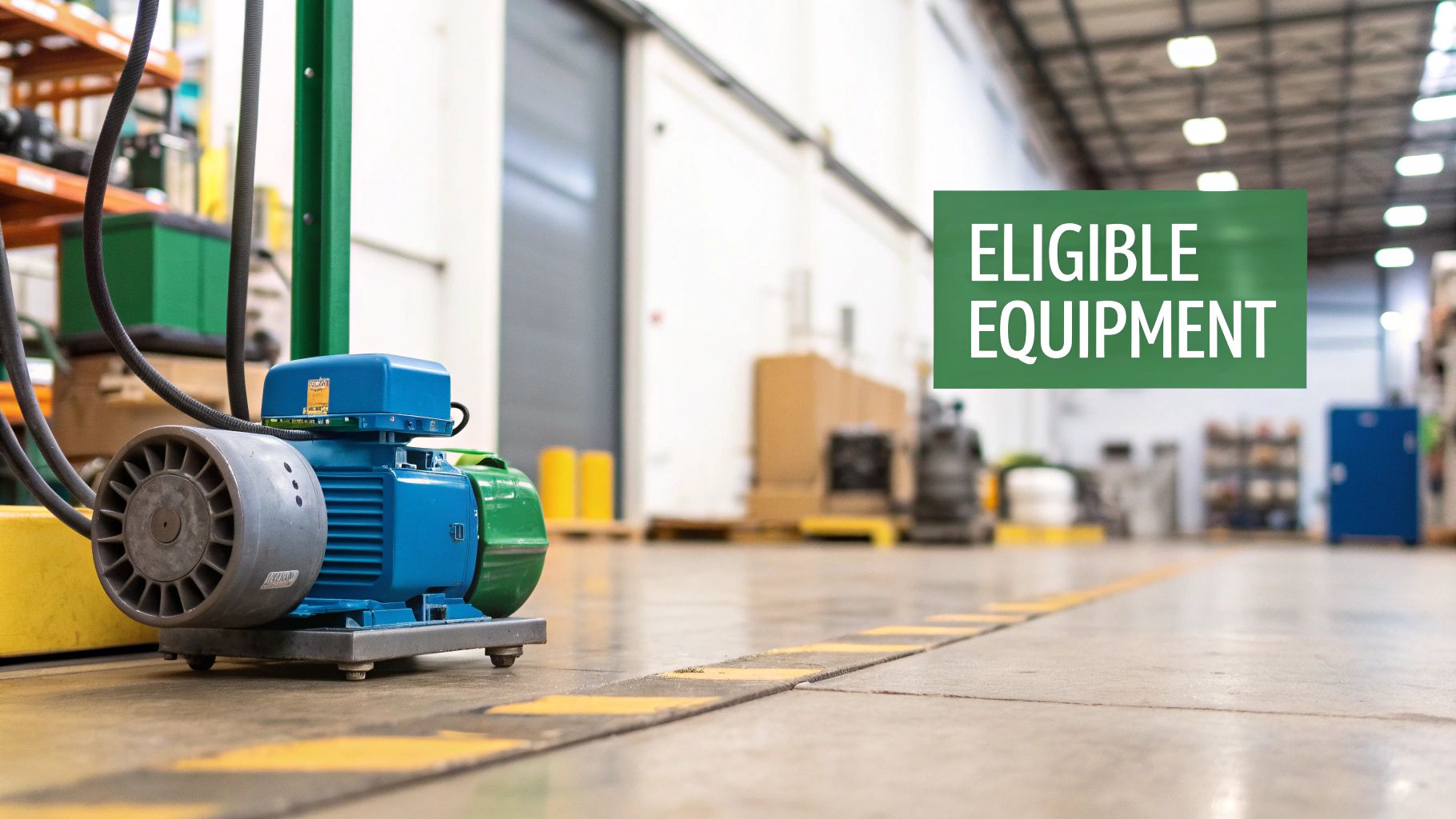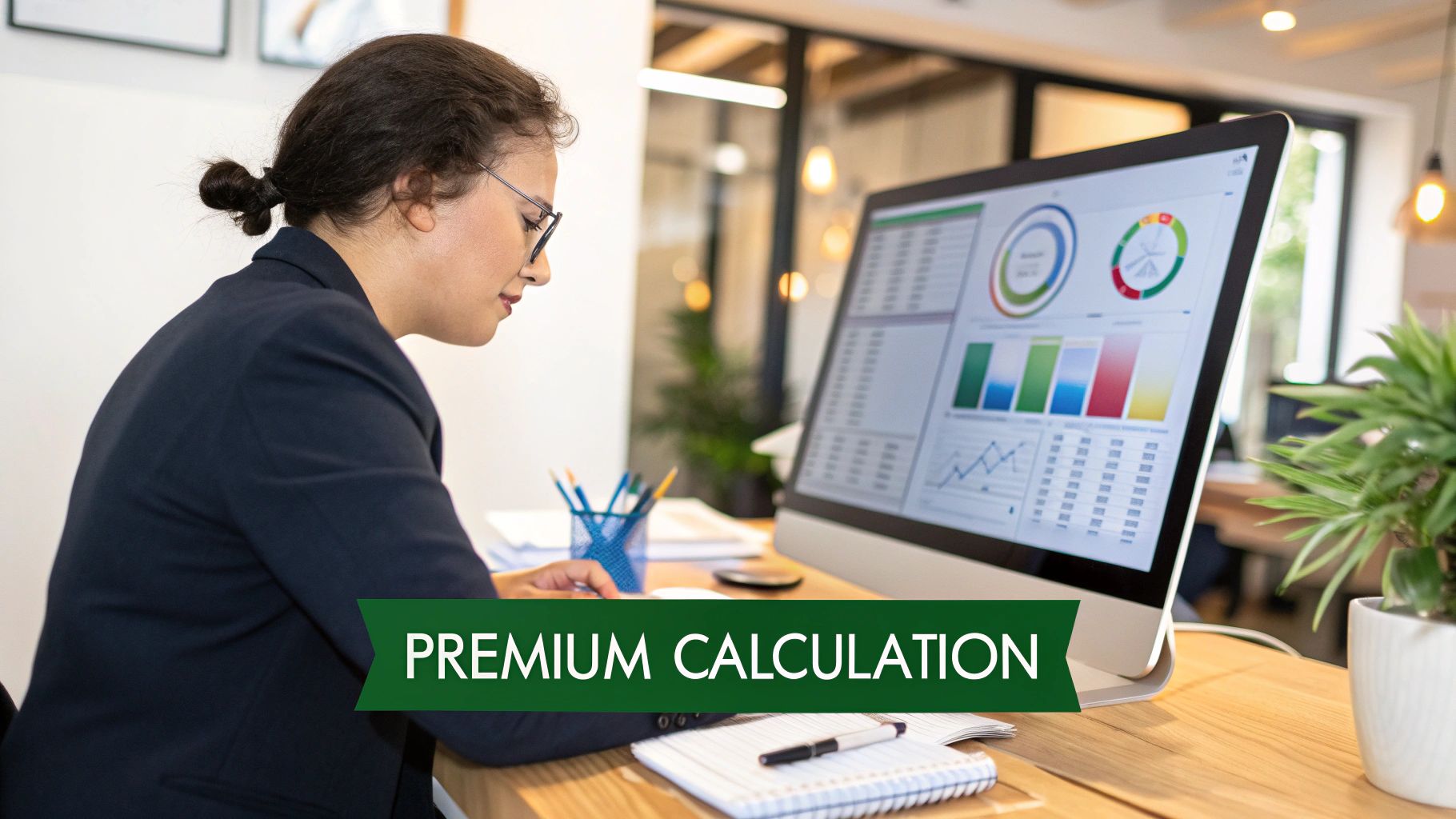Let's be honest—every business relies on machinery to keep things moving, whether it's the HVAC system keeping your office comfortable or the specialized equipment on your production floor. While your standard property insurance is great, it often won't touch failures that happen from the inside out. That's the critical gap equipment breakdown insurance is designed to fill.
Think of it less as just another policy and more as a lifeline for your mission-critical machinery.
What Is Equipment Breakdown Insurance, Really?
Many business owners get a nasty surprise when they discover their commercial property insurance doesn't cover every type of equipment failure. It’s a common—and often expensive—misconception. A standard property policy is built to protect you from external events like a fire, a burst pipe from a storm, or a break-in.
But what about damage from internal forces? Things like power surges, electrical arcing, mechanical explosions, or motor burnout are typically excluded. This is precisely where equipment breakdown coverage steps in. It’s designed to shield your business from the financial shock of a sudden, accidental, and often catastrophic failure of your vital equipment.
This isn't a warranty or a maintenance plan for predictable wear and tear. It’s true protection against the kind of unexpected breakdowns that can bring your operations to a screeching halt.
The Lifeline For Your Operations
Here’s a simple way to look at it: Your commercial property policy is the roof that protects your building from a hailstorm. Equipment breakdown insurance is the specialist you call when the building's vital systems—its heart, lungs, and central nervous system—suddenly fail.
This coverage is surprisingly broad and can apply to a wide range of systems you depend on every day:
- Mechanical Systems: Boilers, pressure vessels, HVAC units, elevators, and water pumps.
- Electrical Systems: Transformers, circuit breaker panels, and electric motors.
- Computer and Tech Equipment: Servers, phone systems, security systems, and point-of-sale (POS) systems.
- Production Machinery: Any specialized manufacturing or processing equipment essential to what you do.
This coverage is built on two core pillars of protection, which are essential to understand.
As you can see, this is about much more than just paying to fix a broken machine. It’s about protecting your business’s financial stability when that machine goes down.
A sudden breakdown is never just a repair bill. It’s also about lost income during downtime, spoiled inventory that has to be thrown out, and the extra costs you rack up just trying to get back to normal. This policy is designed to cover that entire ripple effect.
Equipment Breakdown vs. Commercial Property Insurance
It's easy to confuse these two policies, but they cover very different types of risk. Here’s a quick comparison to make the distinction crystal clear:
| Scenario | Covered by Equipment Breakdown Insurance? | Covered by Commercial Property Insurance? |
|---|---|---|
| An electrical surge fries your main server, causing data loss and business interruption. | Yes | No |
| A fire starts in the kitchen and damages your building and your walk-in freezer. | No | Yes |
| Your HVAC system's compressor suddenly seizes up and fails mechanically. | Yes | No |
| A tornado tears the roof off your building, and rainwater damages your office computers. | No | Yes |
| Your main boiler cracks and explodes due to internal pressure, damaging the boiler room. | Yes | No (Explosion is an internal event) |
This table shows how these two coverages work in tandem. One protects you from outside forces, and the other from internal failures. You truly need both for comprehensive protection.
This kind of coverage is usually added as an endorsement to a broader policy. To see the bigger picture, it helps to understand what is a business owners policy and how it bundles these different protections together. By adding equipment breakdown coverage, you're closing a dangerous gap in your risk management plan, ensuring an internal malfunction doesn't escalate into a full-blown financial crisis.
What Does This Insurance Actually Cover?
Let's get past the jargon and dig into what equipment breakdown insurance actually protects. This coverage isn’t for machinery that simply gets old and wears out; it’s for those sudden, catastrophic internal failures. Think of it as a safety net for when a machine has its own internal crisis, abruptly and without warning.
The whole policy hinges on one key phrase: a "covered breakdown." This isn't just any old failure. It’s a specific kind of malfunction—one that’s sudden and accidental. It’s the motor that burns out in a flash, not the one that's been sputtering and slowing down for months. This distinction is crucial, as it separates a covered event from a standard maintenance issue.
Defining a Covered Breakdown
So, what really counts as a "sudden and accidental" failure? These incidents usually fall into three main buckets of internal damage, each capable of bringing your operations to a grinding halt.
1. Electrical Breakdown
This is the most common culprit behind claims, often triggered by things like power surges, short circuits, or electrical arcing. It's the silent threat that can fry sensitive electronics in the blink of an eye. For example:
- A voltage spike from the power grid takes out your main server.
- A transformer overheats and burns out, plunging your entire facility into darkness.
- Your production line’s control panel short-circuits, stopping all work instantly.
2. Mechanical Breakdown
This is all about the physical failure of moving parts. Imagine the internal gears of a machine seizing up, a critical component fracturing, or a motor simply giving up the ghost. Real-world scenarios include:
- The compressor in your main HVAC unit seizes because of a lubrication failure.
- A conveyor belt motor burns out, halting your assembly line.
- A key bearing in a pump fractures, causing the pump to fail completely.
3. Pressure System Breakdown
This category covers equipment that operates under internal pressure or vacuum, where a sudden failure can be especially dangerous—even explosive. Common examples are:
- A boiler cracking or bursting due to an unexpected spike in pressure.
- A hot water heater imploding because its safety valve malfunctioned.
Our increasing reliance on these complex systems is a major reason the machinery breakdown insurance market is growing so fast. Valued at $2.75 billion, the market is expected to grow at a compound annual rate of 7.10% and hit $4.15 billion by 2030. This growth is fueled by new technologies and rising repair costs. You can explore more about these market trends to understand the bigger picture and how it affects businesses like yours.
What Isn't Covered
Knowing what your policy doesn't cover is just as important as knowing what it does. This insurance is not a maintenance plan or an extended warranty. It’s specifically designed to exclude predictable problems.
Equipment breakdown insurance is designed to protect you from the unexpected, not the inevitable. It covers the sudden failure, not the slow decline.
Here are some common exclusions you need to be aware of:
- Normal Wear and Tear: This includes gradual deterioration from age and use, like a belt that's been slowly fraying for months.
- Corrosion or Rust: Slow degradation of materials over time is considered a maintenance responsibility.
- Software Issues: Problems caused by computer viruses, programming errors, or software bugs aren't covered.
- Improper Maintenance: Failures that happen because you didn't follow the required upkeep schedule.
Understanding these boundaries helps you see equipment breakdown insurance for what it is: a powerful, targeted tool for protecting your business from sudden, internal disasters.
The True Cost of an Equipment Failure
When a vital piece of your equipment suddenly dies, your mind probably jumps straight to the repair or replacement bill. And yes, that direct cost can be a tough pill to swallow. But in my experience, that’s rarely the whole story. It's usually just the tip of the iceberg.
The real financial damage from an equipment failure is a chain reaction. The indirect costs start to pile up fast, and they can easily eclipse the price of the machine itself. Think of it like a fender bender. Fixing the dented bumper is the direct cost. But what about the rental car you need, the time you miss from work, or even the potential medical expenses? Those indirect costs add up. An equipment breakdown is no different, sending financial shockwaves through your entire operation.
This is exactly where a good equipment breakdown insurance policy shows its value. It's designed to see past the broken part and cover the full financial fallout.
More Than Just a Repair Bill
The total impact of a breakdown goes far beyond a single invoice from a repair technician. Without the right coverage, your business is left to absorb every single expense, turning a simple mechanical failure into a serious financial threat. It’s these hidden, secondary costs where the real pain is felt.
Let’s break down what you’re truly facing:
- Direct Property Damage: This is the most obvious one. It’s the cash needed to fix or replace the equipment itself, whether that’s a $5,000 HVAC compressor or a $50,000 piece of specialized manufacturing machinery.
- Business Interruption: Every hour your business is crippled by down equipment, you're bleeding money. This lost income, especially if the failure hits during your busy season, can quickly become your biggest expense.
- Spoiled Inventory: Imagine a walk-in freezer failing. For a restaurant, grocer, or pharmaceutical company, the loss of perishable inventory like food, chemicals, or medicine can be financially devastating.
- Extra Expenses: These are the costs you incur just to keep your doors open. You might have to rent temporary equipment, pay for rush shipping on parts, or even outsource work to a competitor to meet a deadline.
A Real-World Breakdown Scenario
To put this into perspective, let's walk through a common scenario. A local restaurant's walk-in freezer gives out overnight. The compressor fails, and by the time the staff arrives in the morning, everything inside has thawed. The fallout is immediate and costly.
The initial problem was just a single broken compressor. But the ripple effect led to $15,000 in spoiled food, two full days of lost business waiting for a replacement unit, and the extra cost of an emergency rental freezer to salvage what they could.
In this situation, equipment breakdown insurance would cover more than just the new compressor. It would also reimburse the restaurant for the value of the spoiled food and the income lost while the business was closed. It’s designed to address the complete financial picture, turning a potential disaster into a manageable setback.
This protection works hand-in-hand with what you can learn when researching the business interruption insurance cost for your company, providing a comprehensive safety net.
Which Businesses Depend on This Coverage Most?
While almost every modern business relies on some kind of equipment, for certain industries, a sudden breakdown is more than just a hassle—it's a direct threat to their survival. For these companies, equipment breakdown insurance isn't a "nice-to-have" add-on; it's a fundamental piece of their risk management plan.
Does your business fall into this category? The more specialized and essential your machinery is, the more vulnerable you are. The global market for this type of insurance tells the story: it was recently valued at $2.5 billion and is expected to nearly double to $4.8 billion by 2032. This isn't just a random trend. It's a clear signal that businesses are more reliant on complex equipment than ever before. You can discover more insights about these market trends to understand why this coverage is becoming so crucial.
The Pillars of Industry
Some sectors are quite literally built around the constant, reliable operation of their machinery. For them, any downtime immediately halts operations, leading to lost revenue and, in some cases, catastrophic consequences.
1. Manufacturing and Production
Picture an assembly line grinding to a halt because a single, small motor burns out. That's the daily reality for manufacturers. A fried CNC machine, a snapped conveyor belt, or a faulty hydraulic press doesn't just slow things down—it stops them completely. This means immediate financial bleeding and the risk of failing to meet contract deadlines.
- Mini-Scenario: A bottling plant’s main filling machine has a sudden mechanical failure. Production stops dead for 48 hours. As a result, they miss a major delivery window and end up losing a key retail client.
2. Restaurants and Hospitality
In the food service and hospitality worlds, refrigeration and cooking equipment are the lifeblood of the business. A walk-in freezer that dies overnight can easily spoil thousands of dollars worth of inventory. If a commercial oven gives out during the dinner rush, it can tank an entire evening's revenue and damage the restaurant's reputation.
- Mini-Scenario: A hotel's boiler system fails from a pressure system breakdown, leaving guests with no hot water. The fallout is immediate: the hotel must issue refunds and scramble to manage a flood of negative online reviews.
The Unseen Essentials
Even businesses that don't rely on heavy machinery have critical systems humming away behind the scenes. For most office-based companies, the technology and climate control systems are the unsung heroes of the operation.
For a modern office, the server room isn't just a closet with computers—it's the central nervous system. A power surge that fries the server can paralyze the company, wiping out communications, data, and productivity in a single moment.
This is exactly where equipment breakdown coverage acts as a lifeline. It’s designed to protect the very assets that power your day-to-day work, from the servers holding your critical data to the HVAC system keeping your team and customers comfortable. This coverage is a key piece of any solid risk management plan, much like the strategies found in our guide to creating a business continuity insurance strategy. By protecting these essential systems, you ensure a simple mechanical failure doesn't escalate into a full-blown business crisis.
How Equipment Breakdown Insurance Is Priced
Trying to figure out the cost of equipment breakdown insurance can feel like a guessing game, but it’s actually more straightforward than you might think. Insurers don't just pull a number out of thin air. Instead, they look at a handful of very specific things about your business to calculate a premium that matches your real-world risks.
One of the best parts about this coverage is that it’s surprisingly affordable. It’s almost never sold on its own. It's designed to be added as an endorsement to a bigger policy, like a Business Owner's Policy (BOP) or a Commercial Package Policy (CPP). This approach makes it a highly economical way to plug what could otherwise be a very expensive hole in your coverage.
Key Factors That Determine Your Premium
The final price you pay comes down to a few core elements tied directly to the machinery you rely on every day. Think of it as a risk assessment of your operations.
- The Type and Value of Your Equipment: A small accounting firm with a few computers and an HVAC system will naturally have a lower premium than a manufacturing facility running millions of dollars in specialized production machinery. The more it would cost to replace everything, the higher the premium.
- The Age and Condition of Your Equipment: Insurers love to see well-maintained, newer equipment because it’s simply less likely to fail unexpectedly. If you have detailed maintenance logs and your key systems are in good shape, that can work in your favor.
- Your Industry: A restaurant is a great example. Between the walk-in freezers, commercial ovens, and critical ventilation systems, the risk of a costly breakdown is much higher than it is for, say, a small retail boutique. Your industry is a huge clue to how much you depend on your equipment.
- Your Claims History: Just like with any other insurance, a track record of frequent claims can suggest a higher risk to the insurer, which might be reflected in your premium.
It's also worth noting that external factors play a role. With the rise in extreme weather, electrical grids are under more strain than ever, leading to more power surges that can fry sensitive electronics. This growing environmental risk has made solid equipment coverage even more vital.
Your Role in Setting the Price
While insurers look at your business, you’re not just a passenger in this process. You have direct control over two key levers that can significantly move the needle on your premium. Getting these right is all about balancing your budget against the level of protection you need.
Choosing the right deductible and coverage limits is a strategic decision. A higher deductible will lower your premium, but you'll pay more out-of-pocket when a claim occurs. It's about finding the sweet spot that fits your risk tolerance and financial situation.
The two main levers you can pull are:
- Your Deductible: This is the amount you agree to pay first before your insurance coverage starts. Opting for a higher deductible, like $2,500 instead of $500, shows the insurer you're willing to handle the smaller incidents yourself, which rewards you with a lower premium.
- Your Coverage Limits: This is the maximum dollar amount your policy will pay for a covered breakdown. The higher your limit, the more protection you have for a catastrophic failure, but this will also nudge your premium upward.
By working with your agent to adjust these two figures, you can fine-tune a policy that gives you peace of mind without breaking the bank. A great way to see how these numbers affect your overall costs is to use a tool like our commercial property insurance calculator to model a few different scenarios.
Navigating the Claim Process When Disaster Strikes
When a critical piece of equipment suddenly goes down, it feels like chaos. The first few minutes are all about managing the immediate fallout, but having a clear plan for your equipment breakdown insurance claim is what really turns a crisis into a manageable bump in the road.
Your absolute first move is to secure the area. This is about preventing a bad situation from getting worse, whether that's more damage or, even more importantly, an injury. If a boiler bursts, you need to shut off the water and power immediately. If an electrical panel starts arcing, get everyone clear and call a qualified electrician to safely size up the danger.
Once the immediate hazard is contained, grab your phone and document everything. I mean everything. Before a single thing is moved or touched, take photos and videos of the damaged equipment from every conceivable angle. Capture the surrounding area, too. This visual proof is gold for your claims adjuster.
Taking Action After the Initial Shock
With the scene safe, it's time to get the official claims process rolling. Acting fast here is the key to getting your business back up and running.
-
Notify Your Insurer Immediately: Don't wait. Call your insurance agent or carrier as soon as you possibly can to report what happened. The sooner they’re in the loop, the sooner they can get an adjuster on your case and walk you through what comes next.
-
Mitigate Further Loss: You have a duty to take reasonable steps to protect your property from more damage. This might mean throwing a tarp over exposed machinery or moving perfectly good inventory away from the mess. Whatever you spend on temporary fixes or protective measures, keep the receipts.
-
Preserve the Evidence: This is a big one. Do not throw away or start repairing the broken equipment until your insurer has inspected it. The adjuster needs to see the failed parts firsthand to figure out what caused the breakdown.
A well-organized claim is a fast claim. Keeping detailed maintenance and service logs for your equipment beforehand can dramatically speed up the process. These records help prove the failure was sudden and accidental, not due to neglect.
Finally, keep a running log of every conversation, every expense, and every action you take related to the claim. Staying organized helps your insurer, but it also gives you a clear, consolidated record of the entire event. As you navigate a claim like this, it’s also a good moment to review all your business protections. Our guide on understanding management liability coverage can offer more perspective on protecting your company's leaders.
Still Have Questions About Equipment Breakdown Insurance?
It's completely normal to have a few lingering questions, even after digging into the details. This kind of insurance can feel a bit complex at first. Let's tackle some of the most common things business owners ask when they're trying to figure out if this coverage is right for them.
Is This Just Another Word for a Warranty?
Not at all—they're two very different things. Think of it this way: a manufacturer’s warranty is there to fix defects from the factory, usually for a pretty short period. It’s for when a product was built wrong.
Equipment breakdown insurance, on the other hand, steps in for the unexpected, accidental failures that happen during operation. It covers things like a crippling power surge, a sudden mechanical seizure, or an internal short circuit. A standard warranty will almost never cover these kinds of internal meltdowns.
So, Does It Cover Normal Wear and Tear?
This is a crucial point to understand: no, it does not. This policy is built to protect you from sudden, unforeseen breakdowns, not the slow, predictable decline of aging equipment. It's not a replacement for a solid maintenance budget.
Your policy is there for the catastrophic failure of a well-maintained machine, not for the predictable replacement of a worn-out part. This focus on "sudden and accidental" is what keeps coverage affordable.
What About the Equipment I Lease?
That’s a great question, and the answer lies in your lease agreement. If the contract says you're on the hook for any damage, you absolutely need to make sure your policy covers that leased gear.
The best move is to pull out your lease paperwork and walk through it with your insurance agent. This is the only way to be certain you've closed any potential gaps, ensuring all your critical assets—whether you own or lease them—are protected from a surprise failure that could shut you down.
Don't leave your business vulnerable to a sudden breakdown. The team at Wexford Insurance Solutions can help you find the right equipment breakdown endorsement to protect your operations and your bottom line. Get a clear, competitive quote and secure your peace of mind today.











